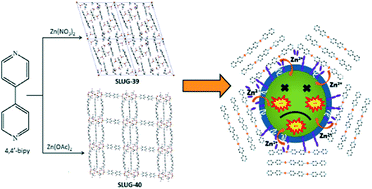Two structurally diverse Zn-based coordination polymers with excellent antibacterial activity†
Abstract
We report the synthesis and antibacterial properties and mechanism of two Zn-based coordination polymers (CPs). The first, [Zn(bipy)(OH2)42+]1.5[ClO4−]3·(bipy)3(H2O), consists of a one-dimensional (1D) structure with two crystallographically independent octahedral zinc centers trans-coordinated by two 4,4′-bipy units and water groups. The second, [Zn1.5(CH3CO2)2(bipy)2+][ClO4−]·H2O, is a two-dimensional (2D) layered structure with the same polymers but bridged together into a layer by acetate and 4,4′-bipy. Both compounds exhibit sustained release of Zn2+ ions upon their gradual degradation in aqueous solution, which results in highly effective antibacterial activity towards Escherichia coli and particularly towards Staphylococcus epidermidis cells. This activity was evaluated in solution by broth dilution assays to determine minimal inhibition concentrations (MICs) as well as in the solid phase by agar diffusion tests to quantify the zones of inhibition (ZOI), and were in close agreement. Further, the biocidal mechanisms of the coordination polymers were investigated in vivo by fluorescence microscopy utilizing CellRox Green and propidium iodide as reactive oxygen species (ROS) and membrane disruption indicators, respectively. Both CPs show superior antibacterial activity compared to two standards, zinc acetate and zinc oxide, which is concluded to be due to both gradual and localized release of Zn2+ ions as well as electrostatic attraction to the bacterial cell surface afforded by their unique structures. This unique Zn release profile and interaction with bacterial surfaces affords marked antibacterial activity and suggests that manipulation of the Zn structures could lead to significant advancements in antimicrobial materials.

- This article is part of the themed collection: Editor’s Collection: Bio-applications of MOFs


 Please wait while we load your content...
Please wait while we load your content...